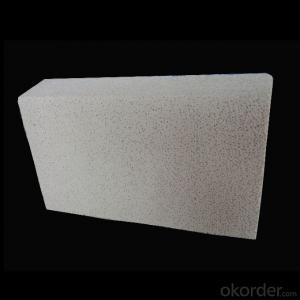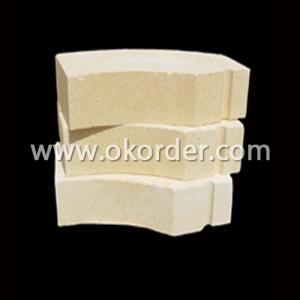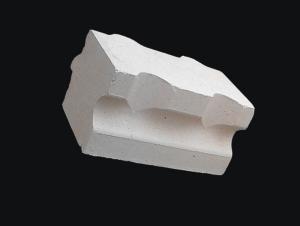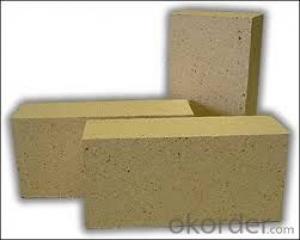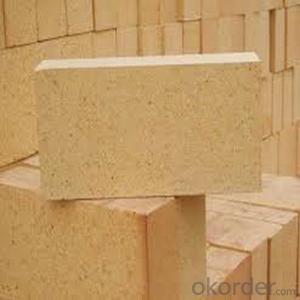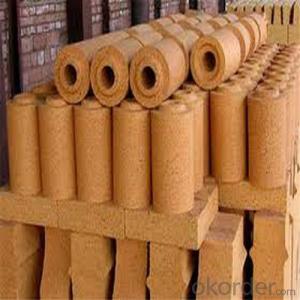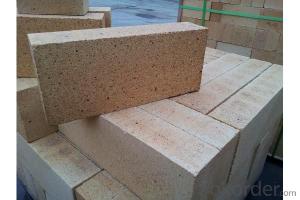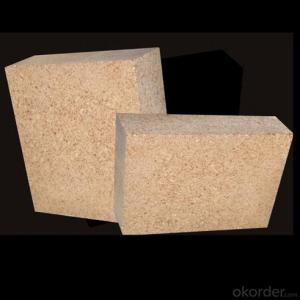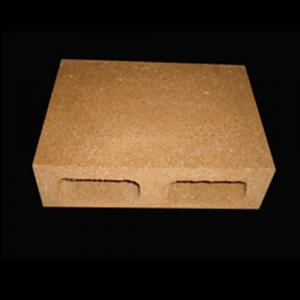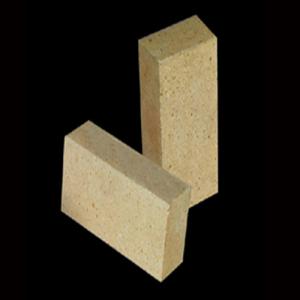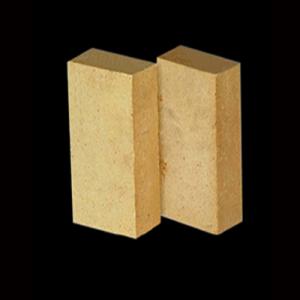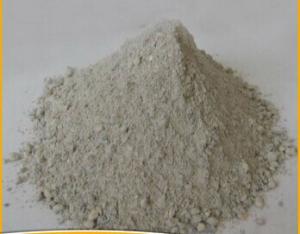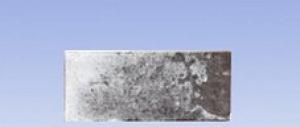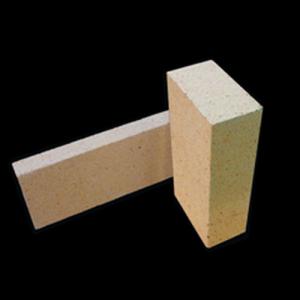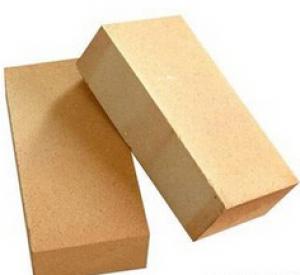Refractory Brick/Super Duty Fireclay Brick
- Loading Port:
- Tianjin
- Payment Terms:
- TT OR LC
- Min Order Qty:
- 20 m.t.
- Supply Capability:
- 20000 m.t./month
OKorder Service Pledge
OKorder Financial Service
You Might Also Like
Product Description
Refractory Brick / Super Duty,Dry Press Fireclay Brick
Refractory's Super Duty Fireclay Brick meeting ASTM regular type classifications,
Key Features:
High Strength,
Lower shrinkage,
Good Alkalis Resistant,
Good resistant to Thermal Shock
Typical Applications:
Carbon baking pit furnace fluewalls and Head Walls, Air Heaters, Combustion Chamber, Boilers, Stacks
Chemical Compositions (Approximate)
Silica (SiO2) 53.10%
Alumina(Al2O3) 42%
Iron Oxide(Fe2O3) 2%
Titania (TiO2) 1.9%
Lime (CaO) 0.3%
Magnesia(MGO) 0.4%
Alkalies (Na2O+K2O) 0.6%
Physical Properties (Typical)
Pyrometric Cone Equivalent
Orton Standard Cones 34
Temperature Equivalent 3187º F(1753º C)
BulkDensity 139lb/ft3
(2.22g/cm3)
Cold Crushing Strength: 4000lb/ft2
(27.5Mpa)
Permanent Linear Change at 2910º F (1600º C) -0.3%
Apparent Porosity 22-24%
Hot load Test Deformation at 2640º F (1450º C) -0.2 to -0.7%
why us
1. We are a manufacturer, which can control the cost easilier than trade company also can give you anwer more quickly.
2. As a manufacturer, we know much in technique and can give you more support in technique problem.
3.We establish the company and began to produce refractory materials since 1988. We have longtime and mature experience for entire production.
4.Our products are complete in specifications with various of sizes.
5. We enjoy a good reputation in the customers in domestic and overseas markets.
- Q:How much is the bending temperature aluminum silicon carbide brick for torpedo car
- High alumina brick is made of superfine alumina, fused corundum and fused mullite as main refractory materials.
- Q:Corundum, high alumina and fireclay refractory difference is what
- They differ in that the alumina content is different, and the content is in order: corundum > high alumina > clay.
- Q:What are the specifications for bricks?
- Thecompressive node as a new type of building energy-saving wall materials, which can be used for masonry walls, but also has good thermal properties, in line with the construction of the building module, reduce the loss in the process of construction, improve work efficiency; the hole rate reached more than 35%, can reduce the weight of the wall, save the foundation engineering cost. Compared with common sintered porous brick, it has the characteristics of heat preservation, heat insulation, light weight, high strength and high construction efficiency. The product is made of shale as raw material. It is produced by high vacuum extrusion molding machine and one yard firing process
- Q:How to reduce porosity of high alumina brick
- In order to reduce the porosity of high alumina brick, the corresponding measures should be taken from the selection of raw materials, batching, mixing, molding and firing.The water absorption rate of the first grade high alumina bauxite clinker should be less than 5%, and the water absorption rate of two grade high alumina material should be less than 7%. Fine grinding of soft clay and bauxite clinker with less than 4% water content. Mixed fine milling ingredients with this, can reduce the porosity of bricks.
- Q:What is the difference between metal compounds and metal solid solutions?
- A series of intermetallic compounds occurring between transition metals in intermetallic compounds. The most important are L sigma sigma phase and ves phase, they are topologically close packed (TcP) phase, they consist of a small atomic radius of a dense layer, which is inlaid with a large atomic radius of atomic structure, this is a highly dense pile. In addition to atomic size factors, their formation is also influenced by the concentration of electrons.
- Q:How to reduce the harm caused by two times mullite in high alumina refractory material
- Prolong the sintering time and adjust the aluminum content of the high alumina brick.
- Q:Is there a big difference between two high alumina brick and one high alumina brick?
- The difference between the two kinds of high alumina bricks is great. I perennial in Zhengzhou was responsible for the production and sale of colt refractories
- Q:What are the alloy wear resistance materials?
- KNMn19Cr2 (patent) high manganese alloy (ZGMn13Cr2MoRe), super high manganese alloy (ZGMn18Cr2MoRe); two: anti-wear chromium cast iron series: such as high, medium and low chromium alloy cast iron (Cr15MOZCu); three: wear resistant alloy steel series: such as, low and high carbon multi metal combined steel (such as ZG40SiMnCrMO and ZG35Cr2MoNiRe); four: ADI (ADI) series; five: all kinds of composite or gradient material and hard alloy materials, nano KN alloy (patent product): such as chromium carbide composite (Cr2C3+Q235), high-energy ion osmosized tungsten carbide materials (WCSP), high toughness of cemented carbide (YK25.6), KN999 nano alloy (Beijing Naimo patent) etc.;
- Q:What is the heat preservation material used in a laboratory furnace?
- Thermal insulation cotton is a high-purity clay clinker, alumina powder, silica powder, chromium sand and other raw materials in the industrial furnace melting at high temperature, forming fluid. Then, compressed air is used to blow or use the wire throwing machine to turn the yarn into a fiber shape. After the cotton collector is collected, the cotton is formed into a heat preservation cotton.The high alumina brick is usually made of high alumina clinker with small amount of clay. After grinding, the high alumina brick is poured and shaped in the form of slurry by the way of gas generation or foam, and it is burnt at 1300~1500 DEG C. Sometimes industrial alumina can be used instead of some bauxite clinker. Used for lining and insulation of masonry kilns, as well as for areas where there is no strong, high temperature molten material erosion and erosion. When contacting the flame directly, the surface contact temperature shall not be higher than 1350 degrees centigrade.
- Q:What causes breakage of refractory bricks?
- Refractory brick is a non metal mineral products can be used in the high temperature of 1550 DEG C under belongs to a class of inorganic, used in high-temperature furnace lining materials as protection kiln, which causes damage, usually have these points.Furnace temperature is not clear, there is no corresponding choice of refractory bricks.Physical impact, abrasion and erosion cause damageChemical factors, especially chemical industry, should be made of refractory bricks, which should be resistant to penetration and erosionIV: products from the factory when the factory did not pass the quality inspection standards
1. Manufacturer Overview |
|
|---|---|
| Location | |
| Year Established | |
| Annual Output Value | |
| Main Markets | |
| Company Certifications | |
2. Manufacturer Certificates |
|
|---|---|
| a) Certification Name | |
| Range | |
| Reference | |
| Validity Period | |
3. Manufacturer Capability |
|
|---|---|
| a)Trade Capacity | |
| Nearest Port | |
| Export Percentage | |
| No.of Employees in Trade Department | |
| Language Spoken: | |
| b)Factory Information | |
| Factory Size: | |
| No. of Production Lines | |
| Contract Manufacturing | |
| Product Price Range | |
Send your message to us
Refractory Brick/Super Duty Fireclay Brick
- Loading Port:
- Tianjin
- Payment Terms:
- TT OR LC
- Min Order Qty:
- 20 m.t.
- Supply Capability:
- 20000 m.t./month
OKorder Service Pledge
OKorder Financial Service
Similar products
New products
Hot products
Related keywords

